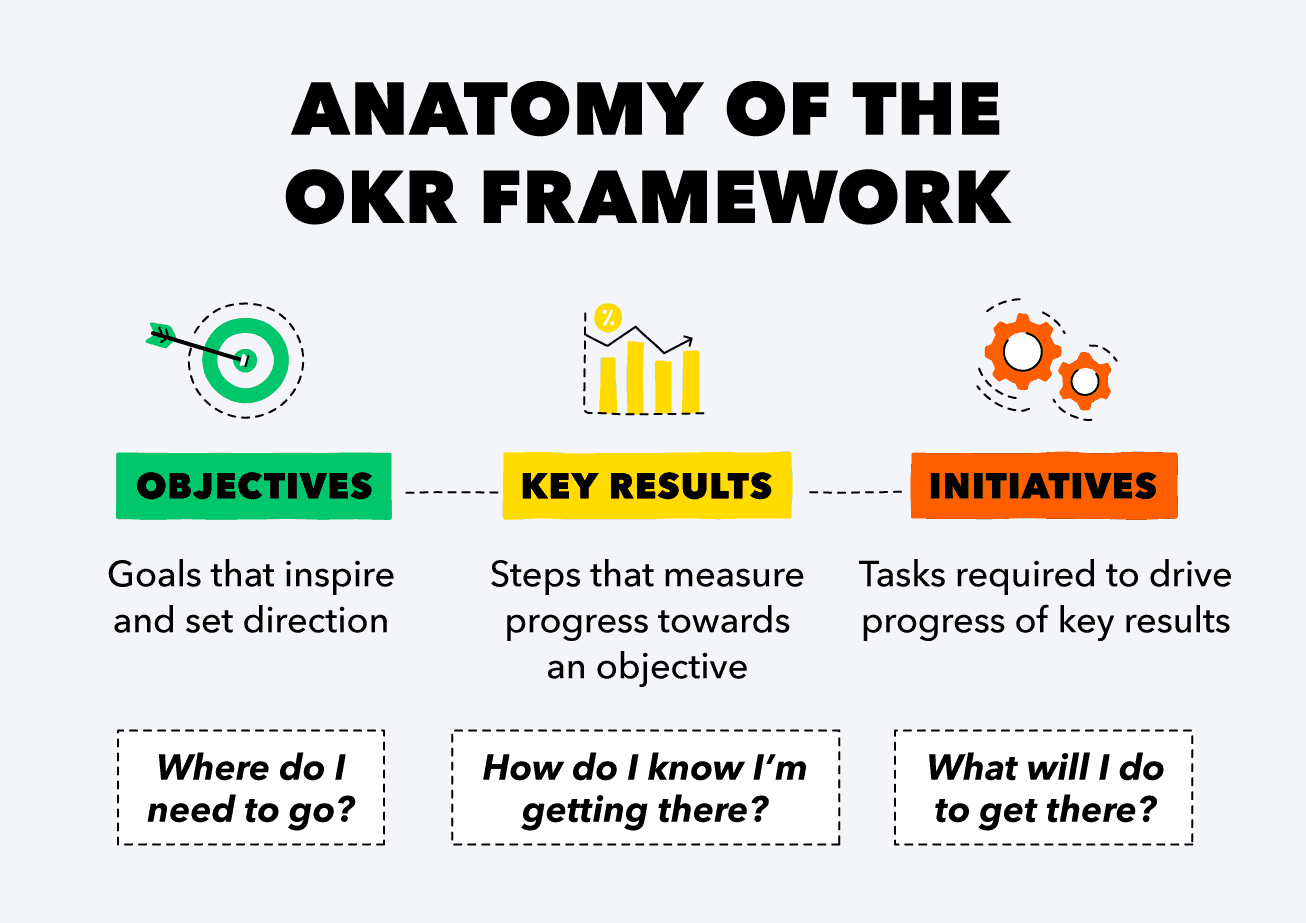Last updated on 7th June 2024
For creative teams – productivity is perhaps THE key driver of success.
Sure, ideas and inspiration are super important.
But the ability to turn around great work at scale and get the work done is one of the most prized skills in any creative industry.
So how do you go about unlocking high levels of team productivity?
Frankly, it relies on a potent blend of motivation, efficiency, communication and automation.
Stick around, and we’ll share 17 actionable tips for unlocking serious productivity gains in your team!
1. Goals
Just as a journey begins with a clear destination…so productivity begins with being clear about exactly what you want to achieve.
There’s a clear correlation between goal-setting and productivity.
Goals keep your team on-task, enthused about what they’re trying to achieve, and motivated to do their best work. And the best goals aren’t based around outcomes (that you can’t control) but instead based on actions (that you can control).
For example, instead of your goal being ‘get 5,000 subscribers on our brand YouTube channel‘, it should be something like ‘Post YouTube videos twice a week for one year.’
This is something you have complete control over and will naturally help you grow your subscriber count. It’s something that your team can be held accountable for and can feel excited about.
One goal-setting model that distils this idea nicely is OKRs.

This is a great way to make people entirely accountable for their own ‘part’ of what you’re trying to achieve, in a very numerical, quantifiable, binary way.
2. Give ownership
One of the key ways to help people be more productive is to give them ownership of projects – and decision-making power.
This removes layers of decision-making bureaucracy, stops people waiting for input from higher-ups, and can improve their satisfaction by giving them agency to pull ‘levers’ and make things happen in their role.
It also gives them more control over their performance and greater room to shine.
Getting used to ‘owning’ projects and making decisions isn’t always easy for less senior team members and can cause its own problems.
More often than not, it’ll be the right thing – building their confidence and empowering them to start to make decisions without asking.
If you’d prefer a different course of action, you can explain that in a positive way.
3. Systemise your process
Systems and processes create repeatability, consistency, allow less room for mistakes – and build a structure within which people can do their best work.
For example, when creating animated videos through our sister brand Wyzowl, process is absolutely at the heart of everything we do and ensures our projects keep moving forward.
Without our process, creating our product as efficiently as we do simply wouldn’t be possible. Things would take so much longer and be so much messier.
Start by breaking your overall work into the constituent parts. For example, when we create a video, it requires…
Script > Storyboard > Animation
At each of these stages, create guidelines for:
– How long do they have to work on the project?
– What happens when a project starts? (e.g. is there a kick off call? A creative meeting?)
– What’s required of them in order to get to the next stage?
– What happens when a project’s ready to move forward? (e.g. is there a handover meeting? A debrief?)
Fixed turnarounds, clear processes and best practices aren’t particularly sexy but they can quickly become the lifeblood of your company.
And – far from being something that inhibits or limits our creativity in any way – our process is one of our key selling points. It’s something we passionately talk about to our customers, because it simply reduces friction, re-work and wasted time. It makes our lives – and, more importantly, our customers’ lives – that much easier.

4. Smash information silos
In any project that involves a number of people, information silos can quickly become a problem.
What that means in simple terms is:
– People spending time digging around for files they need.
– Friction between teams and customers based on miscommunication or crossed wires.
In a world where everyone seems to have their own system for working – their own way of organising and sharing files, their own private communication systems, their own paper to-do lists – it’s so easy for things to become disorganised!
One of the keys here is to use a dedicated Project Management system. Tools like Project.co are very much designed as an antidote to the information silos that kill team productivity.
Each project on Project.co brings together the people who are collaborating on a project or piece of work, and gives them a central set of tools to keep that project organised: a unified discussion feed, file sharing, a ‘Notes’ section for important info, and powerful but simple ‘Tasks’ that can be allocated to people, assigned dates and statuses.
As well as this, you can also use things like Google Drive – with a clearly organised file system that’s explained to every new person you hire.
Above all it’s about consistency: get people signed on to one unified way of working and you’ll avoid so much hassle down the road!
5. Encourage time blocking
It’s important to preface this point by saying there are a LOT of time management techniques out there – time blocking may or may not be the right thing for you.
But it’s certainly one worth trying.
Time blocking came to our attention in the book Deep Work by Cal Newport. The book refers to a variety of ways to ‘divide up’ your day/week according to different tasks.
And it estimates that a 40 hour time-blocked work week, produces the same amount of output as a 60+ hour work week without structure.
If you and your team spend a lot of time on ‘reactive’ stuff like checking your inbox, replying to Slack messages, or unproductive meetings, this is a good thing to look into – although it takes some thought to make it work across your organisation.
Check out the video below to find out more:
6. Allow break periods
It can seem counterintuitive to talk about break periods – after all, you’re looking for more from your team, right?
The thing is, the human brain is a complex thing and comes with finite resources. There’s only so much work we can do without shutting off.
If we don’t allow time for ourselves to go offline – our brains simply take matters into their own hands and shut off themselves.
This is why sometimes, despite all our best efforts and motivation, we find ourselves staring into space, scrolling our phone or simply unable to push ahead with the work, even though we know it’s important and needs to be done.
Scheduled break periods are important, then, because they help to avoid fatigue, burnout and procrastination.
And they allow us to factor those ‘down periods’ INTO our day rather than letting them derail us.
One interesting model comes in the shape of the Pomodoro technique: a model whereby you work for 25 minutes, rest for 5. After repeating this 4 times, you then take a longer, 15-30 minute break.

How you spend those rest periods is completely up to you, but make sure they are actually rest periods – get up and get away from your desk if possible, and completely switch off from the task at hand.
7. Don’t micromanage
We’ve already talked about the power of autonomy but this is something that’s going to massively help both morale and productivity.
Again, the evidence backs this up…
The data is clear: employees are happier when they’re given time and space to do their best work!
So how do you move forward on this?
– Make sure each project has a ‘point person’ – someone who owns it at any given stage. And actually empower them to lead it!
– Remember that standing by people’s ability to make decisions – means you also have to support them if they make the wrong ones.
It’s important to balance this by being available and approachable, too. But ultimately it comes down to the fundamentals – hire good people, and trust them!
8. Work environment
There’s a proven link between where people work, and how well they work: that’s well-established.
Traditional research long ago concluded that temperature, water quality, lighting and noise were all issues that influenced people’s concentration at work.
But more recent research found that many more factors can enhance productivity: including indoor air quality, thermal comfort, layout of individual workspaces, workplace colour schemes, interior plants, dust levels and biological contaminants and indoor carbon dioxide concentration.
That’s a lot to think about. And particularly now, in the post-pandemic world, many employers don’t even have any real control or input into any of these things, as many continue to work remotely.
So perhaps the best advice is to be consultative, rather than top-down.
An open, constructive dialogue with your employees encourages them to raise any issues they have with their working environment.
Educate your team about the impact of these factors on productivity, and support where possible – logistically and financially – where environments can be improved.
9. Foster team relationships
There’s something a little cringeworthy and old-fashioned about the notion of ‘team building.’
But there’s a reason why businesses have been encouraging their staff to build rafts, solve puzzles, run races and play games together for the best part of a century!
Are those things the best way to do this? Not necessarily!
But positive team relationships can benefit companies in so many ways.
For a start, when people get along, they’re much more likely to assume the best of each other – making issues like giving and receiving feedback much easier to navigate.
People also tend to cooperate better when they have good relationships – which improves communication on projects, reduces re-work, saves time and boosts productivity.
Again, social events are one obvious way to build these relationships – but don’t discount things that actually happen as part of your working day.
10. Incentives
There’s no getting around the fact that sometimes, when looking to increase productivity for a short period – for example, racing to meet a deadline – incentives are an important way to tap into peoples’ motivation and get that short-term boost.
An ‘incentive’ can be just about anything, so it’s important to give this a lot of thought. After all, the things that motivate people are as unique and diverse as the people themselves!
It’s easy to burn through money and turn people off by getting incentives wrong. Frankly, if you have a highly altruistic team that’s intrinsically motivated, extrinsic rewards won’t budge their output at all.
It’s important then, to make sure you know your team. Make a judgement call – or you might even want to look into some personality testing to help you better grasp and appreciate what’s important to your team.
11. Praise and recognition
It’s one of the most basic items in your team productivity toolbox, but it might just be one of the most effective.
Offering praise and recognition when a job’s done well, is an incredibly basic but incredibly powerful way to create a culture of positivity and productivity.
It’s natural to think first about public praise, but often private recognition goes down better. It’s less showy and somehow feels more sincere.
Another thing that really makes an impact is public recognition from peers. The more you can encourage people to celebrate themselves and each other the better your company will be.
It helps create a high benchmark of performance that everyone in the business wants to live up to.
12. Constructive feedback
‘Feedback’ is a simple word for a big topic.
We’ve already talked about praise and recognition, which can often be conflated with feedback – but the truth is feedback can, and often should be, critical and challenging.
The right type of feedback in creative roles can unlock significant productivity gains, because it’s direct, succinct and clear. It lets people know exactly what’s expected so they can get there more quickly in future projects.
13. Training and time for personal development
It’s a no-brainer that improved knowledge and skills can make people more productive.
The better and more skilled people are, the less time it generally takes them to complete their tasks.
Allowing time in the diary for training, obviously, takes people out of their work for limited periods.
However, it also gives people time and freedom to explore new ways to get better results – and do more in less time. It isn’t a time expense – it’s a time investment!
As well as job-specific training, don’t rule out the idea of specifically training people on productivity.
Time keeping and workload management aren’t some nebulous topics – they apply to pretty much everyone in every walk of life.
Giving your team guidance on how to prioritise work and time management strategies might encourage them to think about the way they work in more detail – making them happier, healthier and – ultimately – more productive.
14. Automation
An increasingly hot topic in business, automation is a way to reduce and – sometimes – remove time spent doing busy work.
There are times when automation refers to actual AI – chatbots, for example, are a great way to automate customer service and deal with ‘first line’ customer requests.
But there are times where ‘automation’ is simply about using foresight and being proactive to reduce repeated future work.
Classic examples include FAQ sections – stopping you repeatedly answering commonly asked questions – and customer message scripts.
15. Documentation
Similarly, documentation can help deliver content in a repeatable, consistent way.
This is a particularly useful idea when delivered internally.
Training and onboarding, for example, are huge processes that play a key role in how quickly your new hires are able to get up to their full productivity level.
Documentation like handbooks outlining key policies and processes are a great way to help your team navigate particular areas of your service or business.
It helps empower them to find their own answers and solutions to questions and problems, and delivers instruction in a clear way.
It can also eliminate repetitive tasks for your more senior team members. Instead of delivering the same training multiple times – let them put together content that can be delivered time and again without as much input.
16. Fewer (and better) meetings
It’s no secret that meetings can be a colossal time sink for many businesses.
There are a number of ways to change this.
For a start, and most obvious, ditch the unnecessary ‘could have been an email ‘ meetings.
Then, when you’ve identified the ones that are necessary and beneficial, look to shorten them and narrow their focus.
Make sure each meeting leads to actual action points dispersed through your team.
Meetings that repeatedly don’t lead to action points should be eliminated.
17. The right tools
More than a couple of the steps we’ve outlined in this post work a lot better with the right software tools.
Productivity is a deeply personal thing but embracing the right software – and rolling this out consistently across your team – can play a key role in making sure productivity is harnessed at scale throughout your company.
Key areas to consider include:
File sharing – are people routinely able to find the files and information they need?
Communication – is it publicly available, and logged – or squirreled away in people’s inboxes? Are people reachable where, and when, they’re needed?
If the answer to any of these questions is ‘no,’ you’re at a huge disadvantage in terms of optimising productivity.
Final thoughts
Productivity is the lifeblood of any creative team, and getting more from your team can be the difference between a ‘good’ and a truly ‘great’ business.
By implementing some of the steps we’ve discussed in this article, you can unlock new, untold levels of productivity and take your team to the next level!
While you’re here….don’t forget to check out our blog home page for more productivity tips, and if you REALLY want to take your business to the next level, why not take our software, Project.co for a test drive.




